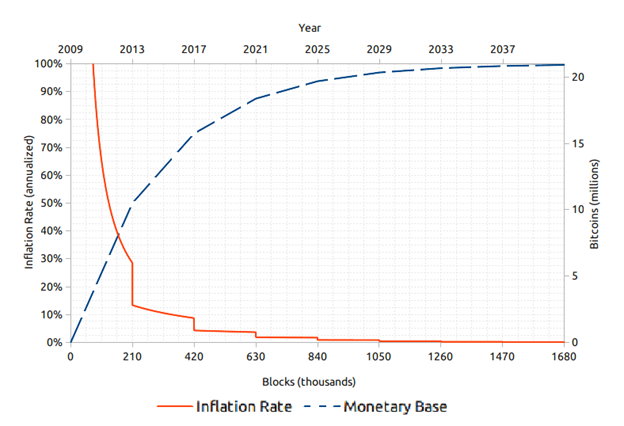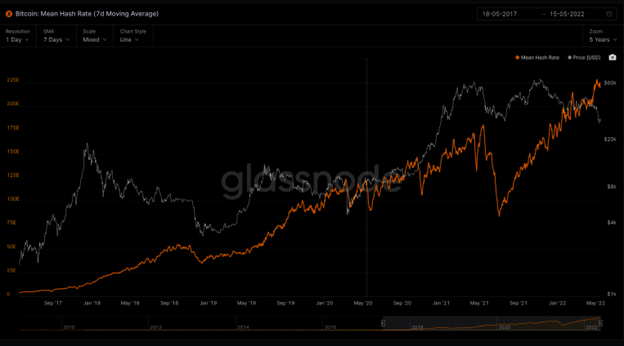Bitcoin shines through crypto markets' negative performance
Crypto markets experienced a meltdown two weeks ago, losing over US$200 billion in one day and much more over the week. But amid the turmoil, once again bitcoin did not disappoint. You may think I am crazy for saying that but let me explain.
Not-so-stable coins
Stablecoins are cryptocurrencies where the price is designed to be pegged to another asset such as a cryptocurrency, fiat money, or to a commodity.
On the 10th of May, an algorithmic stablecoin called TerraUSD (UST) lost its peg to the US Dollar and hovers 87% lower as of the time of writing. Algorithmic stablecoins differ from collateralised stablecoins as they have no reserves. They hold their value based on an algorithm that automatically strikes a balance between the stablecoin and a partner coin. In this case, Terra (LUNA).
The system was designed to automatically maintain its peg to the US dollar, with the failure leading to a systematic devaluing of UST. Meanwhile, LUNA tokens began to be minted at an unprecedented rate, going from 340 million to 6.5 trillion, driving the price lower.
There is speculation that the fall was due to a targeted short attack. But manipulation or not, the UST-LUNA mechanism had a vulnerability that was exploited. The peg didn’t hold up when it was needed most. And if the vulnerability was there, then sooner or later it was bound to be exploited. If the protocol was to be exploited, better sooner than later to avoid even more investor funds at risk.
Not-so-smart contracts
One of the most highly anticipated nonfungible token (NFT) Collections ever, called Otherdeed, was minted earlier in May. But not without frustration and controversy. Yuga Labs’ Otherside, owner of the famous Bored Ape Yacht Club, was behind the launch, which was the largest in history.
For an NFT costing 305 ApeCoin (about US$5,800), it quickly overwhelmed the Ethereum blockchain. This caused gas fees – the amount of Ether (ETH) required for an Ethereum blockchain network user to conduct a transaction on the network – to skyrocket during the drop. Some buyers reported spending anywhere from $6,500 to $14,000 in gas fees alone. Others were charged gas fees even though their Otherdeed transactions failed. This left them with nothing but out-of-pocket expenses of thousands of dollars.
According to Bloomberg, total of roughly $123 million dollars was spent on gas fees alone by the time the drop sold out. (1)
Solana (SOL) is another Top 10 crypto that supports smart contracts, including NFTs. Solana claims faster and cheaper transactions than Ethereum, but it recently suffered a 7-hour outage as NFT minting bots invaded the network. These bots contributed over 4 million transactions per second, knocking validators out of consensus and crashing the network for around seven hours. The most recent outage marks the seventh time this year that Solana has suffered partial or full outages according to its own status reporting on its website. (2)
The biggest drawbacks with DeFi
A recent research report conducted by Cryptomonday.de found that in 2022 alone so far, $1.3B in digital currencies have been stolen. This is already 40% of last year’s total of $3.2B.
Most of the stolen funds (97%) derived from decentralised finance (DeFi) protocol exploits. This is significantly higher than previous years. DeFi hacks accounted for 72% of thefts in the first quarter of 2021 and only 30% in the year prior. (3)
DeFi or decentralised finance is a term for financial services on public blockchains. Services banks offer, such as earning interest, borrowing, lending, and trading, can all be done faster. By using smart contracts, this can be done without a third party.
What did Bitcoin do?
Bitcoin has outperformed all of the top 10 cryptocurrencies such as ETH, BNB and SOL over the year-to-16 May 2022, including the Bloomberg Galaxy Crypto Index (at the time of writing). This is what you want to see from crypto’s perceived ‘reserve asset’.
Source: Bloomberg as at 16/05/22. Past performance is not indicative of future performance.
Compared to equities and fixed income, bitcoin is extremely volatile. But in the land of crypto, in terms of its quality (not volatility), it has retained its leading status among digital assets. Bitcoin has not only outperformed most of the crypto market during the downturn, but has also outperformed most crypto equities. Of course, we are talking about relative performance here – bitcoin’s price decline has nevertheless been substantial.
As a result, bitcoin’s dominance over the entire crypto market has increased dramatically, accounting for 44.42% of crypto’s market cap, VS 40.8% a little over a week earlier according to Coinmarketcap.
Monetary policy
Investment markets are going through turmoil, in part because of high levels of inflation stemming from unprecedented amounts of money printing by global central banks. But unlike fiat, bitcoin cannot be printed out of thin air.
Through history, runaway spending repeatedly has contributed to the downfall of the high and mighty, including the fall of the Roman Empire, seven Chinese dynasties, England’s Henry VIII (1509-1547), Spain’s King Phillip II (1554-1598) and the Weimar Republic (Germany) in the 1920s.
One of the main attractions of bitcoin is its scarcity, with the max supply known to all at 21 million. We also know the inflation rate of bitcoin (currently 1.8% p.a.), which is roughly equal to annual expansion of gold. No other digital asset possesses an immutable monetary policy on the level of bitcoin. Bitcoin's monetary policy may therefore be viewed as the most credible among digital assets.

Security
In 13 years, the Bitcoin network has never been hacked, it has never been frozen, and the network has never gone down. The network has proven to be very resilient in times of stress. The Bitcoin blockchain is considered one of the most secure and there is good reason why it uses so much energy.
The proof-of-work consensus mechanism needs computers to process and validate transactions. The more computers compete to validate transactions by trying to guess the next hash, the more secure the network becomes. Hash rate is a key dimension of blockchain network security because it represents how much energy one single entity needs to spend to alter past blocks. A single entity would need 51% of the hash power to take control. So a higher hash rate means it’s harder to alter the blockchain which is what gives Bitcoin its value – at this point, with the amount of hash power being used, it is highly improbable a successful Bitcoin 51% attack could happen due to the exceedingly high costs for an attack. Only a state-sponsored actor with access to massive amounts of equipment and a large, independent power source could even attempt a 51% attack on Bitcoin.
It’s no secret that Bitcoin uses a lot of energy. But this is a network that at its peak had over $1 trillion of investors’ money to protect. When you consider this, the amount of energy that is being used (which is on par to many other industries, but negligible on a global scale) is not only warranted but welcomed by the users of the network.

Bitcoin is different
In my view, bitcoin should not be lumped in with the rest of the cryptocurrency market as it is fundamentally different from any other digital asset. Altcoins compete with one another to solve different problems. Bitcoin is open source, which means anyone can copy the entire code and launch a cryptocurrency that is similar. But given the size of the Bitcoin network, the level of security and the decentralisation, there is little incentive to move to another network a fraction of Bitcoin’s size. At this point, no other digital asset is likely to displace bitcoin’s status as the leading digital asset and as sound digital money.

Learn more
BetaShares offers the broadest range of technology-focused ETFs in Australia providing access to global tech giants, cybersecurity, Australian technology and more. To stay up to date with my latest insights into the digital assets market click FOLLOW below, find out more about investing in crypto with BetaShares here.
References:
2 topics
1 stock mentioned
1 fund mentioned

